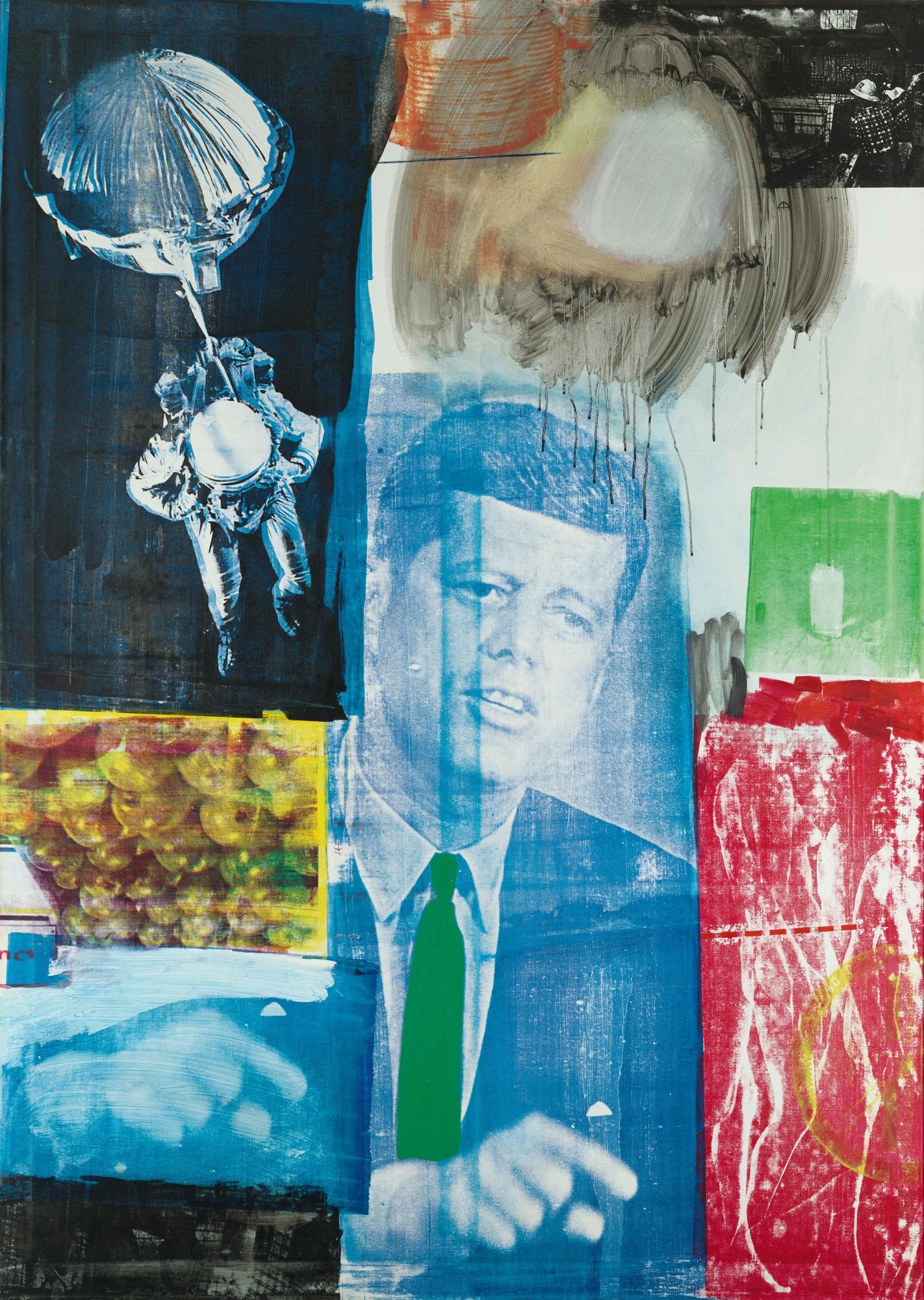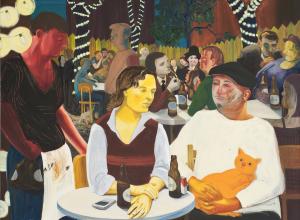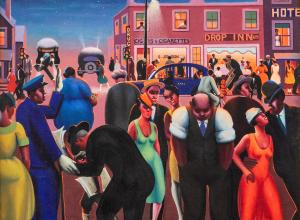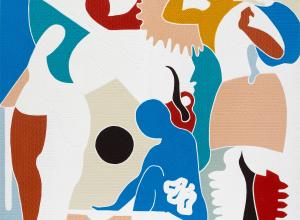
Robert Rauschenberg, Retroactive I, 1963; oil and silkscreen ink on canvas; Wadsworth Atheneum Museum of Art, Hartford, Connecticut, gift of Susan Morse Hilles
Robert Rauschenberg: Erasing the Rules opens at SFMOMA
November 18, 2017–March 25, 2018
A fuse was lit in the 1953 art world when Robert Rauschenberg convinced artist Willem de Kooning to allow him to erase one of his drawings; fellow artist Jasper Johns executed the inscription within the frame: “ERASED DE KOONING DRAWING ROBERT RAUSCHENBERG 1953.” Now seen as a bombshell that shook the foundations of Abstract Expressionism, Erased de Kooning Drawing (1953) is an outstanding example of Rauschenberg’s irreverent yet incisive style, and it famously pushes the limits of what art can be.
This special work was acquired by the San Francisco Museum of Modern Art (SFMOMA) from Rauschenberg through a gift of Phyllis C. Wattis, an instrumental member of the board of trustees who befriended Rauschenberg late in her life. It now anchors the museum’s exceptional holdings of the artist’s early work and is a highlight in the West Coast exclusive of Robert Rauschenberg: Erasing the Rules, on view at SFMOMA from November 18, 2017 through March 25, 2018.
Formerly presented at Tate Modern, London, and the Museum of Modern Art, New York, the exhibition’s iteration in San Francisco pays special tribute to SFMOMA’s close and longstanding relationship with Rauschenberg. From hosting his first retrospective — organized by Walter Hopps in 1976 — to spearheading the recent Rauschenberg Research Project — an ambitious digital resource published on sfmoma.org that makes art historical and conservation research about Rauschenberg works widely accessible — SFMOMA has long been devoted to this extraordinary and trail-blazing figure. This presentation is also dedicated to Phyllis C. Wattis, in honor of her generosity and cherished relationship with the artist and SFMOMA.
“Robert Rauschenberg and Phyllis Wattis were kindred spirits,” said Gary Garrels, Elise S. Haas Senior Curator of Painting and Sculpture at SFMOMA. “Both were eager to discover new ideas that broke old boundaries. They relished life and art with expansiveness of spirit and always with a twinkle in their eyes.”
A defining figure of contemporary art, Rauschenberg produced a prolific body of work across a wide range of media — including painting, sculpture, drawing, prints, photography and performance — frequently and fearlessly defying the traditional art practice of his time. Robert Rauschenberg: Erasing the Rules marks the first retrospective of the artist’s work in nearly 20 years, celebrating the depth and scope of his six-decade career. SFMOMA’s presentation emphasizes his iconoclastic approach, his multidisciplinary working processes and frequent collaborations with other artists.
Largely organized chronologically, the exhibition begins with the artist’s wide-ranging early work, from bold blueprint photograms and intimate photographs to his delicate Scatole personali (boxes filled with found objects). These galleries introduce Rauschenberg’s eagerness to experiment with and break from artistic conventions, his innovative approach to materials and his multi-disciplinary and collaborative nature, all of which were driving forces throughout his career. This early period plays out across three locales: Black Mountain College, a fertile ground for experimentation where Rauschenberg studied with Josef Albers and Hazel Larsen Archer, and undertook his first important collaborations with Susan Weil, Cy Twombly, John Cage and Merce Cunningham; North Africa and Italy, where Rauschenberg traveled with Twombly; and lower Manhattan, where he set up his early studios and worked in close dialogue with Jasper Johns.
Among the many highlights of the exhibition is Automobile Tire Print (1953) in SFMOMA’s collection, made when the artist instructed composer John Cage to drive his Model A Ford through a pool of paint and then across 20 sheets of paper. The layered paper and fabrics in his Black paintings and Red paintings led to the artist’s landmark Combines (1954–64), a body of work that breaks down the boundaries between painting and sculpture. Collection (1954/1955) and Charlene (1954) are presented together for the first time in almost four decades, providing a rare opportunity to see and compare the range of strategies Rauschenberg explored in the Combines’ formative stages. Monogram (1955–59), his landmark work assembled from a taxidermied goat with a painted tire around its body, anchors this presentation.
The exhibition continues by presenting key periods of the artist’s career in depth, including a gallery devoted to transfer drawings and silkscreen paintings. For the Thirty-Four Illustrations for Dante’s Inferno (1958–60), Rauschenberg clipped pictures from magazines and newspapers, illustrating Dante’s epic poem with images from contemporary American life. Rauschenberg’s merging of classical themes, art history references, contemporary politics and pop culture culminate in the silkscreen paintings, such as the vibrant Scanning (1963) and Persimmon (1964). Rauschenberg also actively explored technological innovations for his performances and artworks in the early 1960s. Collaborations with Billy Klüver and a team of engineers lead to the inclusion of embedded radios in Oracle (1962–65). For the sound-activated work Mud Muse (1968–71) the artist constructed an enormous vat of vigorously spurting and bubbling mud. Originally conceived for an exhibition in Los Angeles and inspired by a hydrothermal basin in Yellowstone National Park, this presentation marks Mud Muse’s first return to California since 1971.
In 1970, Rauschenberg relocated his primary residence and studio to Captiva Island, Florida, where he lived and worked for the rest of his life. These new surroundings prompted the creation of the series Cardboards (1971–72). SFMOMA’s Rosalie/Red Cheek/Temporary Letter/Stock (Cardboard) (1971), one of the earliest of the series, encapsulates this move with a mailing label from Rauschenberg’s New York studio to his Captiva address affixed to its front. Far from isolated in Florida, Rauschenberg constantly welcomed visitors, many of them artists, and continued to travel frequently. A trip to India inspired his striking, lively series Jammers (1975–76); a 1982 visit to China ultimately lead to the launch of ROCI (the Rauschenberg Overseas Culture Interchange), an intense seven-year project encompassing travel, art-making and exhibitions in over 10 countries. Rauschenberg’s own photos from this period of travel appear in many later works including SFMOMA’s Port of Entry [Anagram (A Pun)] (1998).
SFMOMA’s presentation also will be distinguished by a single gallery presentation featuring Hiccups (1978), an extraordinary work comprising 97 pieces of handmade paper, each with transfer images and collaged bits of fabric and ribbon. Individual sheets are connected with zippers, with the intent that they could be reorganized into any order. In 1999, Rauschenberg gave Hiccups to SFMOMA in honor of Phyllis Wattis. This treasured work will be installed as a continuous frieze around the perimeter of a gallery.
The exhibition culminates with Rauschenberg’s late work, including his series Gluts (1986–94), assemblages of scrap-metal that point to the excessive consumption of American society, yet also incorporate humor. The artist’s metal paintings of the 1990s, such as Holiday Ruse (Night Shade) (1991), feature subtly layered images silkscreened onto sheets of aluminum and bronze with tarnishing agents. The color transfer paintings of the 1990s and 2000s employ photographs printed with environmentally-friendly inks via cutting-edge digital printers and image-editing software, a testament to the artist’s ongoing embrace of emerging technologies and materials.
About Robert Rauschenberg
Born in Port Arthur, Texas, Robert Rauschenberg (1925–2008) was creative from a young age, and active in school theatre as a costume and set designer throughout high school. He attended the University of Texas, Austin, before he was drafted into the United States Navy. After his honorable discharge in 1945, he studied at the Kansas City Art Institute and the Académie Julian in Paris, France. Later he attended Black Mountain College in North Carolina, where he studied with Josef Albers, among others.
Rauschenberg launched his artistic career in the early 1950s, during the peak of Abstract Expressionism. Challenging this painterly tradition with an egalitarian approach to materials, he brought objects and images from the everyday world into his art. Working alone as well as in collaboration with artists, dancers, musicians and writers, Rauschenberg invented new interdisciplinary forms of artistic practice that set the course for present day art. He developed new modes of performance work, organized collaborative projects that crossed the boundaries between different mediums and different cultures and created works that merged traditional art materials with ordinary objects, found imagery and the cutting-edge technology of an emergent digital age. Major exhibitions include Robert Rauschenberg: A Retrospective (Solomon R. Guggenheim Museum, 1997); Robert Rauschenberg: The Early 1950s (Menil Collection, 1991); Robert Rauschenberg: The Silk-Screen Paintings, 1962–64 (Whitney Museum of American Art, 1990); and Robert Rauschenberg (National Collection of Fine Arts, 1976).
Rauschenberg’s work took him throughout the U.S. and across the globe, including Central and South America, Asia, Europe and Africa. From 1970, he worked from his home and studio on Captiva Island, Florida.
Education and Public Practice
To accompany the exhibition, SFMOMA will present a range of public programs that explore Rauschenberg’s work. On December 2, 2017, Bay Area educators are invited to visit Robert Rauschenberg: Erasing the Rules, as a part of the Special Saturdays for Teachers series. The museum will also provide free public tours, grade 9–12 school tours and higher education tours during the run of the exhibition. On February 10, scholars, students and curators will convene for a series of panels and discussions on Rauschenberg's relationship to the photographic image in the colloquium Rauschenberg and The Agility of Images. In addition, SFMOMA 101, a three-week public course for adults, will be offered on February 1, February 8 and February 15, 2018 ($60 members/$80 general). These sessions will explore his vast and varied work across his career as well as his influence on contemporary artists working today.
Performance at SFMOMA looks to Rauschenberg’s rich collaborations with postmodern dance innovators. On January 11–13, Performance in Progress presents DESIRE LINES: RETROFIT from choreographers and former Merce Cunningham dancers Rashaun Mitchell and Silas Riener. Mitchell and Riener bring a close circle of movement artists to activate museum space and weigh the resonances between dance and visual art. Their performances kick off Limited Edition, a program presented by the museum’s online platform, Open Space. Limited Edition features a season of live work at the museum and at local institutions CounterPulse, ODC Theater, The Lab and Z Space. Limited Edition also includes an offering from SFMOMA’s Performance All Agesseries, providing the opportunity for audiences of all ages to join the artists of BodyCartography Project on March 17–18 for drop-in participatory movement pieces that connect to Rauschenberg’s performances.
Select programs in conjunction with Robert Rauschenberg: Erasing the Rules are made possible through a grant from the Robert Rauschenberg Foundation.
Catalogue
Robert Rauschenberg: Erasing the Rules is accompanied by a richly illustrated catalogue, which examines the artist’s entire career across a full range of mediums. Edited by Leah Dickerman and Achim Borchardt-Hume, the book features commissioned essays by eminent scholars and emerging new writers, including Yve-Alain Bois, Andrianna Campbell, Hal Foster, Mark Godfrey, Hiroko Ikegami, Branden W. Joseph, Ed Krčma, Michelle Kuo, Pamela M. Lee, Emily Liebert, Richard Meyer, Helen Molesworth, Kate Nesin, Sarah Roberts and Catherine Wood. Each essay focuses on a specific moment in Rauschenberg’s career, exploring his creative production across disciplines. Integrating new scholarship, documentary imagery, and archival materials, this is the first comprehensive catalogue of Rauschenberg’s career in 20 years.
Organization and Support
Robert Rauschenberg: Erasing the Rules is organized by Tate Modern, London, and The Museum of Modern Art, New York, in association with the San Francisco Museum of Modern Art.
The Global Tour Sponsor is Bank of America. Major support is provided by Carol and Lyman Casey, Doris Fisher, The Mimi and Peter Haas Fund, SFMOMA Collectors’ Forum, the Paul L. Wattis Foundation, the Phyllis C. Wattis Fund for Traveling Exhibitions, and Carlie Wilmans. Generous support is provided by the Gerson Bakar Foundation, Aurelia and Cadmus Balkanski, Penny S. and James G. Coulter, Roberta and Steve Denning, Dana and Bob Emery, James Hormel and Michael Nguyen, the Mary Jo and Dick Kovacevich Family, Christine and Pierre Lamond, Deborah and Kenneth Novack, the Bernard and Barbro Osher Exhibition Fund, the Prospect Creek Foundation, Chara Schreyer, Helen and Charles Schwab, Thomas W. Weisel and Janet Barnes, and Bobbie and Mike Wilsey. This exhibition is supported by an indemnity from the Federal Council on the Arts and the Humanities.
The exhibition is curated by Achim Borchardt-Hume, Director of Exhibitions, Tate Modern, London, and Leah Dickerman, The Marlene Hess Curator of Painting and Sculpture, The Museum of Modern Art, New York. The SFMOMA presentation is organized by Gary Garrels, Elise S. Haas Senior Curator of Painting and Sculpture, and Sarah Roberts, Andrew W. Mellon Associate Curator of Painting and Sculpture, San Francisco Museum of Modern Art.
Hours and Admission
Open Friday–Tuesday 10 a.m.–5 p.m. and until 9 p.m. on Thursday. Closed Wednesday.
Annual membership begins at $100, and members enjoy free admission. Adult general admission to SFMOMA is $25; admission for seniors 65 years and older is $22; and admission for visitors ages 19 through 24 is $19. Visitors aged 18 years and younger receive free admission to the museum, including special exhibitions.
Private guided tours and group discounts for Robert Rauschenberg: Erasing the Rules are available through the SFMOMA Group Sales Department. Tours are one hour in length and are not included with museum admission. Tours must be booked at least two weeks in advance. For more information or to submit an inquiry, please visit sfmoma.org/groups.




























